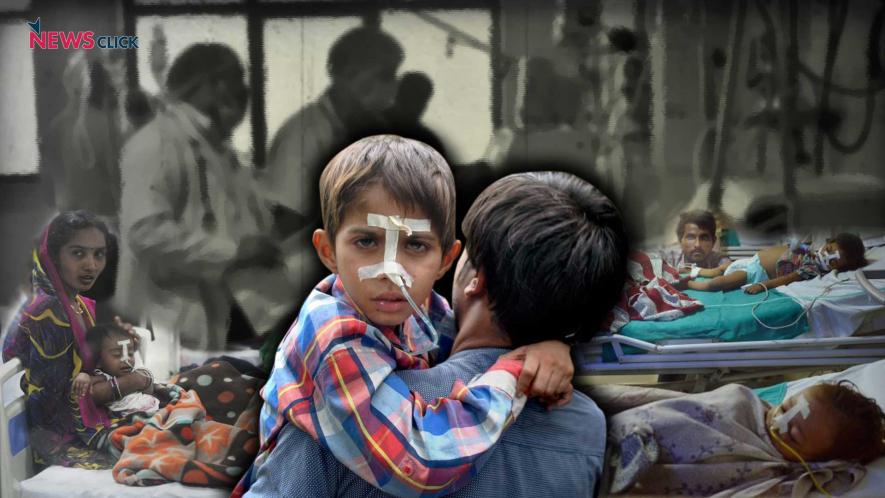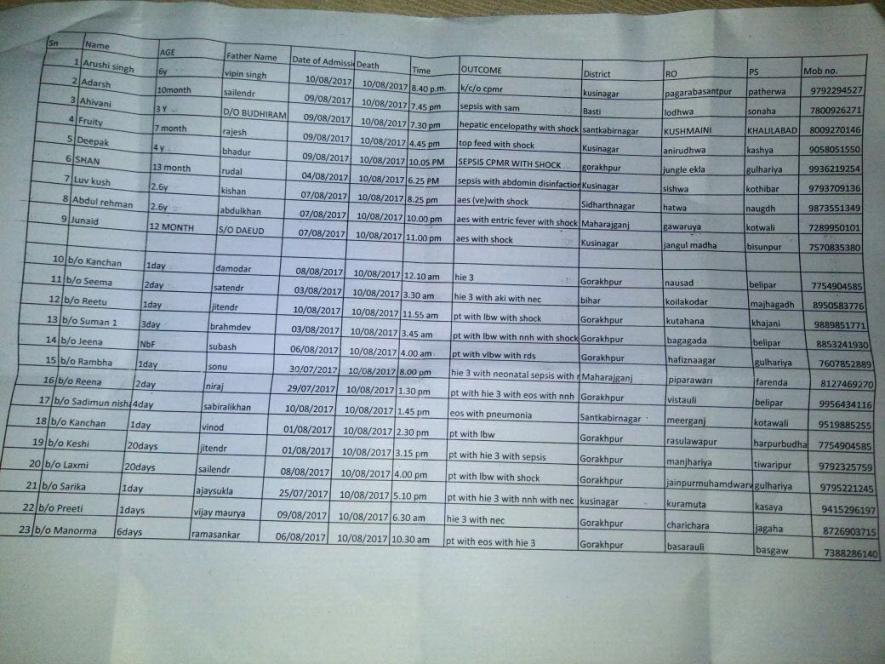Not Only Encephalitis, Lack of Oxygen Also Triggered Gorakhpur Tragedy

Newsclick Image by Nitesh Kumar
The Uttar Pradesh government on Tuesday ordered a registration of FIRs against the doctors and officials of Gorakhpur’s Baba Raghav Das (BRD) Medical College along with Pushpa Sales – the company contracted to supply liquid oxygen – in connection with the Gorakhpur tragedy, in which over 30 children died in on the intervening night of August 10 and 11.
NewsClick is in possession of death certificates of children that shows not all the kids who died were suffering from encephalitis. They had different medical conditions related to birth and disruption of oxygen compounded their problems, resulting in loss of their lives.

The document also underlines that Dr Kafeel Khan, who was earlier hailed for going extra miles for saving the lives of many children, but later removed as the nodal officer for the Department of Paediatrics, was made scapegoat.
So what happened in the BRD Hospital on the fateful night?
Balwant Gupta, oxygen operator, BRD Medical College and Hospital told an India Today investigating team that they had 52 oxygen cylinders. When liquid air supplies dropped at 7:30 pm on August 10, some other staff replaced them with cylinders.
“We use 16 of them in one go. When I took over (the shift), all the stocks were exhausted by 11:30 pm. I had informed everyone (hospital staff) in the ward that we will run out of cylinders in a couple of hours. They were told to prepare ambu bags for emergency. I informed doctors and the staff. I don’t know what would have happened if I had disclosed this to patients (attendants/parents),” he said.
There are reports that parents were asked to keep pumping air into their children using an ambu bag (a bag like a football bladder that is used as a temporary measure when oxygen is not available) for hours till their hands went numb.
A damning revelation: According to Balwant Gupta, supplies dipped to a dangerous low at 7:30 pm from the storage tank. By 11:30 pm, BRD ran out of its stock of cylinders. And that was when an emergency was sounded.
The vehicle carrying the cylinders was running late. Yes, it took at least two hours when new cylinders arrived. It came in at 1:22 am on August 11 and the supplies were resumed at 1:30 am on August 11.
“Were you there? Did you see the children dying? What caused the deaths?” asked the investigating team of the news channel.
The answer was, “Oxygen supplies. What else? Supplies should have been adequate. They weren’t and that is why they (children) suffered.”
A government enquiry has indicted the then BRD Principal Rajeev Mishra, Chief Anaesthetist Dr Satish Kumar and Chief Pharmacist Gajanand Jaiswal for the oxygen crisis. Liquid oxygen supplier Pushpa Sales has also been held responsible for disrupting oxygen supply over payment issues.
When asked about the date from which the supply disrupted Gupta said, “The last delivery came on August 4. No delivery after that.”
It means the hospital not only sat on oxygen shortage for almost a week, they didn’t respond to SOS calls for hours when the situation demanded it the most.
Not just oxygen tanks, sensitivity too ran dry at BRD Medical College and Hospital putting a spotlight on our healthcare system.
“I called Superintendent-in-Chief (SIC) at night itself. It rang unanswered. He called back only in the morning at 7 am, asking what happened. He said he would come in at 9 am and would hold a meeting with the people concerned. What was it? He would come at 9 in an emergency situation,” Gupta said.
“The situation was compounded by a sudden disruption in the supply of oxygen by the private company that had been contracted to supply it to the hospital. The immediate effect was that the disruption of oxygen proved fatal for scores of infants who were already in an extremely fragile situation,” Dr Amit Senupta, convenor of People’s Health Movement, told NewsClick.
The hospital is overcrowded, under-staffed and under-resourced, leading to an inordinately high number of deaths in the hospital. It has a budget of just Rs 5.32 crore for medicines, which works out to just Rs 150 per bed per year.
Till July 2017, of the 2,386 new born children admitted to the hospital, 931 died. Reports indicate that in the paediatric ward, three-four children share one bed.
Every year thousands of children in the Gangetic plains of India are affected by encephalitis and about a thousand of them do not survive. UP sees the largest number of such cases and deaths. These figures are based on recorded data, and the actual number is likely to be 2-5 times higher.
Few questions are worth asking here. Who will fix the responsibility of the administration? The Gorakhpur district magistrate and the director general of UP’s health department was already informed. What actions were taken? If not, why not?
Disclaimer: The views expressed here are the author's personal views, and do not necessarily represent the views of Newsclick.
Get the latest reports & analysis with people's perspective on Protests, movements & deep analytical videos, discussions of the current affairs in your Telegram app. Subscribe to NewsClick's Telegram channel & get Real-Time updates on stories, as they get published on our website.























